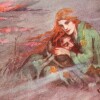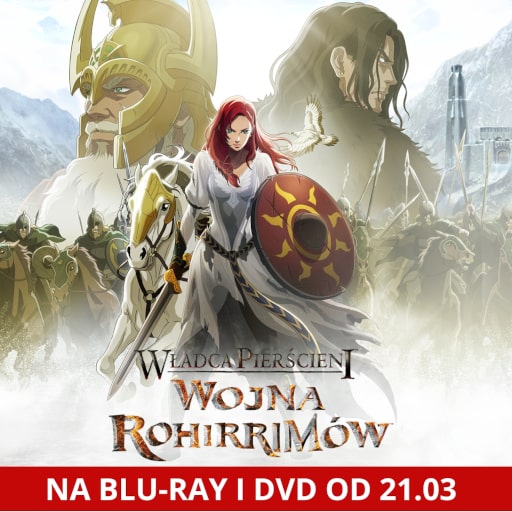In each collection of legends and myths, a hero or heroes with superhuman strength and endurance stands out. Examples include Heracles (Hercules) and Achilles for the Greeks and Romans, Gilgamesh in Mesopotamian mythology, Samson in the Hebrews, and Sigurd Volsung in the Norse Eddas. Such a hero also appears in the Celtic mythology of Ireland. Cúchulainn, because we are talking about him, is one of the greatest warriors and heroes of the Green Island. His adventures are described in the so-called Ulster Cycle. In this text, I am going to introduce you to the silhouette of this extraordinary individual. I invite you.
A hard birth, or how gods come into the world
The origins of the Dog Ulster (as our hero is called otherwise) are said in various ways. That he was born because of a dragonfly swallowed by his mother, and that the father was Sulatam. However, I take as the true version the one in which the king of the gods Lugh was born and mother Dechtere gave him into the world by vomiting. In this particular case, fertilization did not take place, but through the spiritual element. This is how Setanta (the name of the hero at birth) is born of a virgin mother (to feel the breeze of Christianity). Due to his origin, he is not only a demigod, but also a member of the royal family, because his mother was closely related to Conchobar mac Nessa – king of Ulster (being his sister or daughter). Being a prince meant proper upbringing and so young Setanta was taken care of by the ruler’s most famous household members, the most important of whom turned out to be Fergus mac Róich. He taught a young warrior to fight and inculcated the use of these skills to defend the weaker.
A hero’s childhood, or how to become a living prophecy
Little can be said about the hero’s first six years. The stories describe this period quite vaguely. It gets interesting when Setanta reaches the age of seven. At first, against Conchobar’s ban, he goes to Emain Macha to join the boys who play there. He is attacked by them, but manages to defeat them. The brawl is interrupted by the arrival of the king of Ulster. He then gets an invitation with the king to a feast at the blacksmith Culann. He is late, and thus he is forced to fight for his life with a huge dog, which the blacksmith kept to protect the yard. He kills the animal, and seeing the sadness and despair on the host’s face, promises to protect the farmyard until he finds and trains a dog of the same breed. Then the druid Cathbad gives him the name by which he will be known later – Cúchulainn, meaning the Hound of Culanna. Some time later he eavesdrops how the same druid explains to the boys the importance of today. He prophesies that whoever possesses a new weapon that day will gain eternal glory. Setanta goes to Conchobar and asks for a new weapon. However, none of the weapons in the arsenal stand up to his strength. Only the king’s own weapon does it. When druid Cathbad saw it, he was terrified, because the boy did not hear the end of the prophecy. Well, apart from the fame of the chosen one, a short life awaits. In response, Setanta harnessed the chariot and rushed to kill the three sons of Ulster Nechtan’s sworn enemy. On his return, he was still under the influence of battle frenzy. Only the sight of the naked breasts of the queen and her courtiers embarrassed the boy. Then it was thrown into cold water. It took three barrels to cool down. The first one exploded, the second one boiled,
Youth of the Hound, or a few words about acquiring a magic weapon
At this point, there is a leap in the myth’s narrative for several years. We no longer meet a child, but a teenage Cúchulainn. It turns out that he is so handsome that many Ulster warriors fear that their wives will not cheat. A frantic search for a spouse for our hero follows. Setanta, however, falls in love with the beautiful Emer. Her father, Forgall Monach, on the other hand, doesn’t want to hear about his daughter’s relationship with a bloody warrior. He insidiously suggests that the Hound of Ulster travel to the Isle of Skye to study under the goddess Scathach. He quietly hopes that the hero will not survive the camp and will not come back to ask for Emer’s hand. However, this was not to be the case. Setanta not only underwent training, but also met some valuable people, including Feridad, being his blood (or milk) brother and best friend. In addition, he defeated the goddess Aoife in a duel and fathered a son with her. He also became involved with Scathach’s daughter, Uathach. At the end of his stay on the island, he received from the goddess Gae Bolg, who threw him with his foot. After returning to Ulster, he asked Emer again to marry him. The refusal caused him to invade Forgall’s Keep, murder the guards, kidnap Emer, and steal her father’s treasure. His wedding became a fact. Consequently, the law had to be met the first night. Due to fear of the warrior, King Conchobar compromised and the druid Cathbad spent the night between him and Emer. who threw his foot away. After returning to Ulster, he asked Emer again for the hand. The refusal caused him to invade Forgall’s Keep, murder the guards, kidnap Emer, and steal her father’s treasure. His wedding became a fact. Consequently, the law had to be met the first night. Due to fear of the warrior, King Conchobar compromised and the druid Cathbad spent the night between him and Emer. who threw his foot. After returning to Ulster, he asked Emer again to marry him. The refusal caused him to invade Forgall’s Keep, murder the guards, kidnap Emer, and steal her father’s treasure. His wedding became a fact. Consequently, the law had to be met the first night. Due to fear of the warrior, King Conchobar compromised and the druid Cathbad spent the night between him and Emer.
Great years, or the end of the story
Eight years after Setanta’s wedding, a mysterious young man arrived on the shores of Ireland. He defeated every fighter he encountered, and he ignored questions about the name. Finally, Cúchulainn himself stood up to fight the stranger. The duel was long and fierce, but finally the young man fell with Gae Bolg’s dick. Then he exclaimed, “Scathach did not teach me that.” The Hound of Ulster then understood that he had slain his own son born of Aoife. So he lifted the body of the offspring and said to the warriors surrounding him, “You have my son, men of Ulster.”
Some time later, Queen Medb of Connachta wanted to abduct the legendary bull from Cooley. The borders of Ulster are on fire. The attack surprised Cúchulainn completely. He then spent the night with his wife, which made him late to the battlefield. The effect of this was to avoid a spell that would cause all the men on the battlefield to suffer the pains of childbirth. By Setant’s law, he demanded a duel instead of a battle. For months the warrior stood at the border and defeated successive Medb envoys. At last, Fergus, Setanta’s tutor, stood up to fight. Cúchulainn withdrew from the fight in exchange for a promise that the opponent would do the same soon. Medb was furious. Finally she ordered Feridad to fight. The duel between friends was the most difficult challenge for our hero. Finally he defeated his brother. In an act of contrition and reconciliation, he transferred Feridad’s body to the other side of the river, so that he would die with his friends, not his enemies. The Medb army then ordered a retreat, but not for long. After a few months, the attackers attacked again. Cathbad ruled that if Cúchulainn did fight, he would die. Emer tried to stop her husband, but in vain. He ordered the chariot to be harnessed. In amok, he rushed to the battlefield. Just before hitting the enemy, he saw a woman washing his shirt (symbol of death), but that didn’t stop him. The blow knocked Connachta’s troops back, but was quickly surrounded. The fight was so fierce that he had to use his magic weapon three times. Unfortunately, each time the weapon fell into enemy hands. And so, after the first use, Setanty’s coachman died, then the horse, and at the very end he received the wound himself. So he tied himself to the tree, where he died for three days. Despite his weakness, his sight was so terrible that the Connachta army did not consider a further attack. This is where the story of Ireland’s greatest hero ends.
A brief discussion with the myth, or what, what for and why?
The myth of Cúchulainna is, next to the Phoenician Cycle, the basis of Irish mythology. The story of the indomitable demigod is the purest essence of Irish fortitude. The above-mentioned version of the myth was written by me on the basis of various studies and collections of stories that I had read. There are many differences, but the essence remains the same – there is not and will not be a greater hero than Lugh’s son. Analyzing the individual components of this story, one can notice both the inspiration of Christianity and the myths of Latin culture, the influence of which was felt on the Green Island. However, in some respects, this myth is unique on a global scale. While the Heracles, Achilles, Gilgamesh and other Samsonians can be thrown into one sack due to belonging to the Mediterranean circle, so many myths about Sigurd Volsung and Cúchulainna are hard to pigeonhole so easily. It is possible that in the next text I will focus on this first hero, but it will not be until later. For now, I invite you to read this amazing story, which is the mythology of Ireland.
Bibliography:
http://www.maryjones.us/ctexts/index_irish.html


